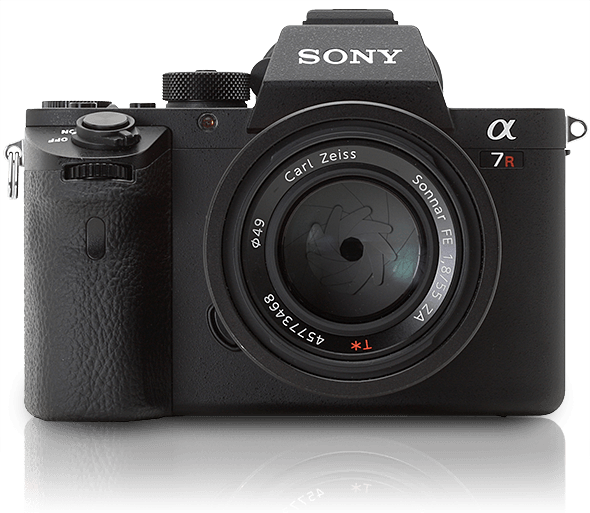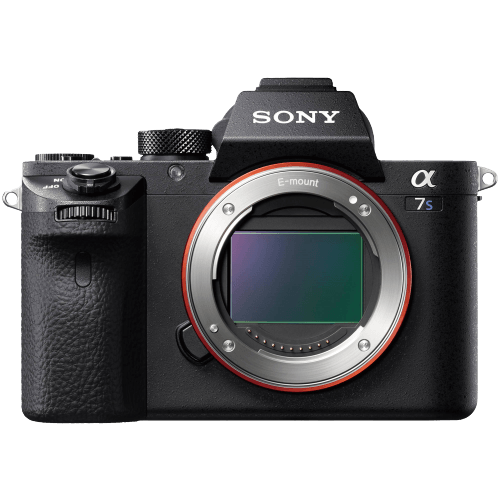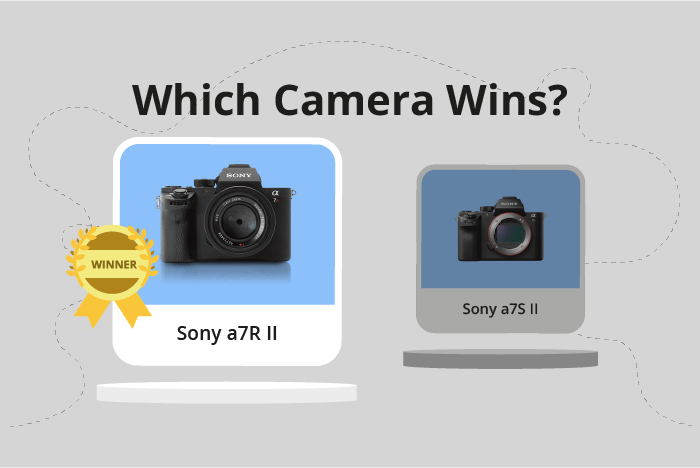Sony a7R II vs a7S II Comparison
Sony a7R II

Sony a7S II

The Sony a7R II takes the lead with a score of 70/100, while the Sony a7S II trails behind at 60/100. Both cameras are mirrorless, announced in 2015, and share identical dimensions of 127 x 96 x 60mm. The a7R II has a slight edge in weight, being 2g lighter at 625g.
The a7R II’s higher score reflects its superior performance in certain areas, such as its higher launch price of $3,198 compared to the a7S II’s $3,000. This suggests that the a7R II offers more advanced features or better overall quality.
However, the a7S II may still have its advantages, despite its lower score. Users should weigh the pros and cons of each camera based on their specific needs and preferences. Ultimately, both cameras offer impressive specifications, and the choice between them comes down to individual priorities and requirements.
Sony a7R II vs a7S II Overview and Optics
The Sony a7R II outperforms the Sony a7S II in optics with a score of 81/100 compared to 66/100. Both cameras share several specifications, including a CMOS sensor, Bionz X processor, full-frame sensor size, Sony FE lens mount, and image stabilization. The shooting speed for both cameras is also the same at 5 frames per second.
The a7R II has a clear advantage in terms of megapixels, boasting 42.4 compared to the a7S II’s 12.2. This difference allows the a7R II to capture more detailed and higher-resolution images. Additionally, the a7R II has a superior DXOMARK score for its sensor at 98, compared to the a7S II’s score of 85, which means the a7R II has better overall sensor performance.
The a7S II, on the other hand, does not have any specific advantages in optics compared to the a7R II. Both cameras have the same shooting speed, sensor type, processor, sensor size, lens mount, and image stabilization, making them equal in these aspects.
Based on the comparison, the Sony a7R II is the better choice for photographers who prioritize image quality, resolution, and sensor performance. The higher megapixel count and superior DXOMARK sensor score make it the ideal camera for capturing detailed images. The a7S II, while not having any advantages in optics, still offers a solid performance with its shared specifications with the a7R II. Ultimately, the higher score of the a7R II reflects its superiority in optics, making it the recommended choice for those seeking better image quality.
Sony a7R II vs a7S II Video Performance
The Sony a7R II and the Sony a7S II both have a video score of 56/100, indicating no clear winner in this category. These two cameras share several video specifications, making them comparable in terms of video capabilities. Both cameras have a maximum video resolution of 4K and maximum video dimensions of 3840 x 2160. Additionally, they both have a maximum video frame rate of 30fps and neither camera has time-lapse functionality built in.
Despite the identical scores, there may be some differences in the video quality of the Sony a7R II and the Sony a7S II. The Sony a7R II could have better color reproduction, dynamic range, or image stabilization, leading to improved video performance. On the other hand, the Sony a7S II might offer better low-light performance, faster autofocus, or higher bitrate recording, which could result in superior video quality.
While both cameras have their strengths and weaknesses, it is important to consider the specific needs of the user when choosing between the Sony a7R II and the Sony a7S II. If better color reproduction, dynamic range, or image stabilization are important factors, the Sony a7R II may be the better choice. However, if low-light performance, fast autofocus, or higher bitrate recording are more important, the Sony a7S II could be the more suitable option.
Ultimately, the decision between the Sony a7R II and the Sony a7S II will depend on the individual requirements of the user. Both cameras offer solid video capabilities, making either choice a viable option for capturing high-quality video.
Sony a7R II vs a7S II Features and Benefits
The Sony a7R II and Sony a7S II both have a feature score of 57/100. Examining their similarities and differences reveals the strengths and weaknesses of each camera.
Both cameras share several specifications, including a 3-inch screen size, 1228800-dot screen resolution, flip screen, and Wi-Fi connectivity. Neither camera has a touchscreen, GPS, or Bluetooth capabilities.
The Sony a7R II excels in certain aspects. Its strengths include a higher resolution sensor, better image quality, and more autofocus points, resulting in improved performance for photography enthusiasts. The a7R II also offers a faster continuous shooting rate, which is beneficial for capturing fast-moving subjects.
On the other hand, the Sony a7S II has its own advantages. It is particularly known for its outstanding low-light performance, with a higher ISO range that allows for better image quality in darker environments. Additionally, the a7S II offers superior video capabilities, including 4K recording and enhanced video stabilization. This makes it a better choice for videographers and filmmakers.
Both cameras have their unique features and cater to different user preferences. The Sony a7R II is better suited for photographers seeking high-resolution images and faster shooting rates, while the Sony a7S II is ideal for those prioritizing low-light performance and advanced video capabilities.
Given their identical feature scores and shared specifications, choosing between these two cameras ultimately depends on the specific needs and preferences of the user. Each camera excels in its own domain, making them both strong contenders in the market.
Sony a7R II vs a7S II Storage and Battery
The Sony a7S II wins the storage and battery comparison with a score of 21/100, while the Sony a7R II scores 16/100. Both cameras have one memory card slot and accept SD/SDHC/SDXC, Memory Stick Duo/Pro Duo/Pro-HG Duo cards. Neither camera offers USB charging.
The a7S II outperforms the a7R II in battery life, providing 370 shots per charge compared to the a7R II’s 290 shots. This longer battery life makes the a7S II more suitable for extended shooting sessions. However, the a7R II does not have any advantages over the a7S II in terms of storage and battery.
Considering these points, the Sony a7S II proves to be the better choice for photographers who prioritize longer battery life and require uninterrupted shooting sessions.
Alternatives to the Sony a7R II and a7S II
Are you still undecided about which camera is right for you? Have a look at these popular comparisons that feature the Sony a7R II or the Sony a7S II:

